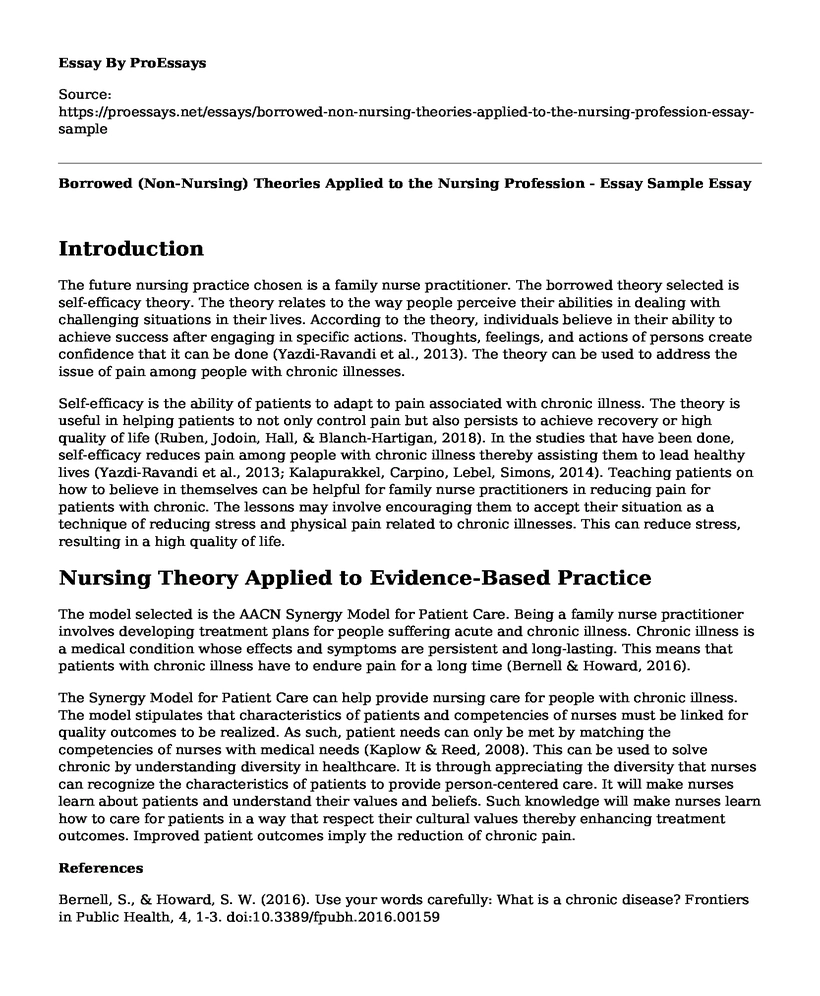Introduction
The future nursing practice chosen is a family nurse practitioner. The borrowed theory selected is self-efficacy theory. The theory relates to the way people perceive their abilities in dealing with challenging situations in their lives. According to the theory, individuals believe in their ability to achieve success after engaging in specific actions. Thoughts, feelings, and actions of persons create confidence that it can be done (Yazdi-Ravandi et al., 2013). The theory can be used to address the issue of pain among people with chronic illnesses.
Self-efficacy is the ability of patients to adapt to pain associated with chronic illness. The theory is useful in helping patients to not only control pain but also persists to achieve recovery or high quality of life (Ruben, Jodoin, Hall, & Blanch-Hartigan, 2018). In the studies that have been done, self-efficacy reduces pain among people with chronic illness thereby assisting them to lead healthy lives (Yazdi-Ravandi et al., 2013; Kalapurakkel, Carpino, Lebel, Simons, 2014). Teaching patients on how to believe in themselves can be helpful for family nurse practitioners in reducing pain for patients with chronic. The lessons may involve encouraging them to accept their situation as a technique of reducing stress and physical pain related to chronic illnesses. This can reduce stress, resulting in a high quality of life.
Nursing Theory Applied to Evidence-Based Practice
The model selected is the AACN Synergy Model for Patient Care. Being a family nurse practitioner involves developing treatment plans for people suffering acute and chronic illness. Chronic illness is a medical condition whose effects and symptoms are persistent and long-lasting. This means that patients with chronic illness have to endure pain for a long time (Bernell & Howard, 2016).
The Synergy Model for Patient Care can help provide nursing care for people with chronic illness. The model stipulates that characteristics of patients and competencies of nurses must be linked for quality outcomes to be realized. As such, patient needs can only be met by matching the competencies of nurses with medical needs (Kaplow & Reed, 2008). This can be used to solve chronic by understanding diversity in healthcare. It is through appreciating the diversity that nurses can recognize the characteristics of patients to provide person-centered care. It will make nurses learn about patients and understand their values and beliefs. Such knowledge will make nurses learn how to care for patients in a way that respect their cultural values thereby enhancing treatment outcomes. Improved patient outcomes imply the reduction of chronic pain.
References
Bernell, S., & Howard, S. W. (2016). Use your words carefully: What is a chronic disease? Frontiers in Public Health, 4, 1-3. doi:10.3389/fpubh.2016.00159
Kalapurakkel, S., A. Carpino, E., Lebel, A., & E. Simons, L. (2014). "Pain can't stop me": Examining pain self-efficacy and acceptance as resilience processes among youth with chronic headache. Journal of Pediatric Psychology, 40(9), 926-933. doi:10.1093/jpepsy/jsu091
Kaplow, R., & Reed, K. D. (2008). Synergy ... The unique relationship between nurses and patients (The AACN Synergy Model for Patient Care). Nursing Administration Quarterly, 32(3), 259-260. doi:10.1097/01.naq.0000325188.32708.98
Ruben, M. A., Jodoin, A. N., Hall, J. A., & Blanch-Hartigan, D. (2018). The impact of acute pain self-efficacy on pain intensity and the accurate recall of pain. Health Psychology Report, 6(2), 136-145. doi:10.5114/hpr.2018.72068
Swickard, S., Swickard, W., Reimer, A., Lindell, D., & Winkelman, C. (2014). Adaptation of the AACN Synergy Model for Patient Care to critical care transport. Critical Care Nurse, 34(1), 16-28. doi:10.4037/ccn2014573
Yazdi-Ravandi, S., Taslimi, Z., Jamshidian, N., Saberi, H., Shams, J., & Haghparast, A. (2013). Prediction of quality of life by self-efficacy, pain intensity and pain duration in patient with pain disorders. Basic and Clinical Neuroscience, 4(2), 117-124. Retrieved from https://www.ncbi.nlm.nih.gov/pmc/articles/PMC4202536/
Cite this page
Borrowed (Non-Nursing) Theories Applied to the Nursing Profession - Essay Sample. (2022, Dec 20). Retrieved from https://proessays.net/essays/borrowed-non-nursing-theories-applied-to-the-nursing-profession-essay-sample
If you are the original author of this essay and no longer wish to have it published on the ProEssays website, please click below to request its removal:
- Quality and Safety Issues Concerning SAID the med' Project
- How Aging, Ethnicity, Life Circumstances and Disease Have Affected an Aging Adult? - Essay Sample
- Disability in Higher Education: The Self-Identification Challenge- Essay Sample
- Improved Discernment & Decision Making: My Rotations - Essay Sample
- Advanced Practice Nurses: Opioid Prescription for Noncancerous Pain - Essay Sample
- Essay Example on Metformin: Approved Diabetes Medication to Reduce Glucose Levels
- 150 Years of St. Elizabeth Healthcare: A History of Providing Quality Care - Report Sample







